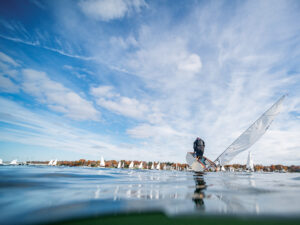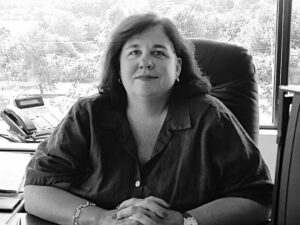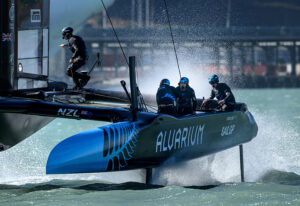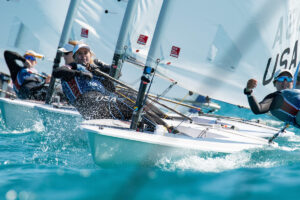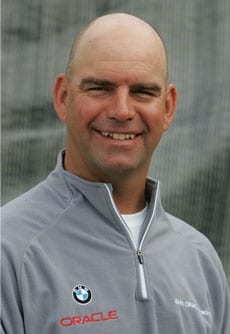
Kostecki 2004HallofFame
You won your first worlds, in the Sunfish, at age 18. How long had you been sailing the Sunfish? Just for a few months because I knew the Worlds were coming. I grew up in San Rafael, Calif., and the Worlds were in San Francisco. A friend of mine was sailing a Sunfish at the time and a group of us decided to get into the class and start doing some training for it. We had a qualifier for the worlds and also did a lot of training at the venue the worlds were-Coyote Point, right next to the airport. It’s very windy there, and we really worked on our breeze set-up with the boats and kind of modified the Jens Hookansen rig. We ended up with a nice boatspeed advantage. I think there were three or four of us in the top 20. What kind of boats were you sailing at the time? Lasers at that point. I grew up sailing since age 7 or 8 out of the Richmond YC training program, through the end of high school. Towards the end of my junior sailing career, I joined the St. Francis YC, in 1979. How close was the event? Derrick Fries, Dave Chapin, and I were all pretty close, and it came down to the last race. In your mind was that a launching pad to thinking, “Gee, maybe I can go some place ” Or had there been other events you felt had launched you? The year before we’d won the Sears Cup in Rowayton, Conn., sailed in J/24s; then came the Sunfish worlds, and the same year we finished second in the J/24 Worlds, also in San Francisco. Did you make any kind of decision about your sailing career at that point? During high school, I was pretty adamant about getting involved with Olympic sailing, so out of high school. After the Sears Cup, Sunfish Worlds, and J/24 Worlds, I said, “Hey I might be able to go to the Olympics.” Why did choose the Soling when its one of the biggest and most expensive boats to get into? That’s a good question, In 1983 I started sailing the 470 and spent about a year sailing it with Zach Berkowitz [who later became International 14 world champion]. We were pretty serious, and we did the ’83 pre-Olympic regatta in LA and a few other regattas. We did OK, but we really struggled in light air. I was on the larger side to be a helmsman, and he was actually a little short and small, so we could never really put it together. How much did you weigh then? I was probably 140 pounds, and in those days, 115 to 125 pounds was the ideal weight (laughs). I didn’t enjoy the ’83 pre-Olympics at all. It was miserable: I was dieting, and I enjoy eating (laughs). Bob Billingham was sailing and he wanted to find a new skipper and he asked me if I wanted to start sailing the Soling. So we just started sailing around and we gave it a try in San Francisco Bay for a few days and I really enjoyed it, so we got another friend of ours from San Francisco, and started sailing. How did you do at that ’84 Trials? We were 8th; it was a pretty tough trials, including Buddy Melges, Dave Curtis, Dave Chapin, Dave Perry, Ed Baird-it was a very deep fleet. We were happy finishing 8th. We won one race. We had a couple other top three finishes. At the end of the day we were really happy. And so at that point you decided to go for ’88? Yeah we had a great time sailing the Soling together and decided to keep doing it and really work on it. The race we’d won at the LA trials had been in breeze and we were really fast in the breeze, so we really wanted to work on our light-air speed after that. That next summer we finished third at the Worlds in Sarnia, Canada, in a light-air regatta. The next year we won our first Soling World Championship in La Trinite, France. Jump ahead to the Pusan Olympics. You’re 24, you’ve won the Worlds, won the Goodwill Games and the Pan Ams. Did you do better or worse than you expected at Pusan, Korea? We had high expectations. We were totally gunning for first. At the time we were disappointed with the silver medal, believe it or not (laughing). In retrospect, where did you go wrong? Or was Jochen Shuemann just a little bit better? His strength was he had been to the Olympics before; he was definitely a lot older and more mature. I think the whole Olympic deal maybe caught us off guard. It was a close regatta, though. It came down to the last beat of the last race. If we won, he needed to be third or worse. We had a great start and were first all the way around the race track, but the wind built to about 25 or 30 knots toward the end of the race. We rounded the first windward mark in first and they rounded ninth, but they were able to sail through the fleet and on the last run they passed the third-place boat. It was so windy that there was no way we could drive him back and put a boat in between us. It was literally like 30 to 35 knots at that point. So we just finished the race first, and they finished second, and they won the gold medal. So, looking back on it, the silver was a good medal. Vince Brun said he’s crewed for you in J/24s. How long and what did he teach you in the process? I have so much respect for Vince. I think he’s one of the best sailors in the world. He has a knack for making boats go fast, and he’s also a very intelligent sailor tactically. When he ended up crewing for me in the J/24, we were pretty dominant in the class. We won the J/24 NAs in San Francisco. I think we were 16th in the first race and then we won the other five or six races in the regatta. We went to the Miami Midwinters and won easily. Anytime he crewed with me in the 24 we were really fast; he was normally the tactician and we went the right way and it made winning really easy. Any particular mentors over the years? I’ve been fortunate to sail with a lot of great sailors: American John Bertrand, Paul Cayard, Tom Blackaller-they’re all from San Francisco Bay. When I was young, I definitely learned a lot from then. I was also able to sail with Dennis Conner in a bunch of regattas and guys like Rod Davis. The list just goes on. I try to learn as much as I can from everybody I sail with. You’ve been progressively sailing bigger boats over the years, successfully: Mumm 36s, Farr 40s, Volvo 60s, AC boats, and maxis. Do you prefer the larger boats and some of the high-profile races like the AC or the Volvo, or has it become more of a business? For sure it’s how I make my living so that’s important. What keeps it enjoyable for me is being able to sail on different types of boats a lot of time. Not just sailing a Star boat, like Mark Reynolds, who has focused on Star boats for the last 20 years. I enjoy the small boats, small keelboats, all the way up to the big boats because they each have their own different challenges. You’ve been watching Paul Cayard really get into the Star, win the Trials, and head for the Olympics. He’s on a real roll. Do you wish you’d had the opportunity to take him on and do you feel like you might yet again go for the Olympics? It was difficult watching it from the Internet, and I think we could have had a good shot at winning or, if not, pushing him harder than he was pushed at the Trials. He’s put a lot of time and effort into it and deserves to go to the Olympics. It appeared to me that he definitely had a nice edge in the Trials, and he definitely has a great shot at winning a medal. We lost twice to Reynolds in 1992 and 1996 in the Star boat where we did an 8 month or 6 month campaign, and that just doesn’t work. Did you drop your campaign this time because you realized you couldn’t put in enough time? It was a combination of things. We had some nice sponsorship lined up to do it. You know it’s quite expensive to campaign the Star these days, and since we were coming in late, we really wanted to push hard and take it to the next level, which meant having coaches on hand, which can be expensive. In the fall of ’03 our sponsorship started being less secure than we thought so that put a damper on things. Then I joined up with BMW Oracle Racing, so it just didn’t make sense to put a lot of time and effort into it and spend our own money. It was a tough decision and really took a long time to make. You’ve had the experience of putting in the comprehensive effort with illbruck, and it sounds like you knew that wasn’t going to happen. It had the potential to be less than ideal as far as a full-on effort. That’s not how I like to do things. I’ve been to the Olympics and I’ve been fortunate enough to have had the experience, and I’ve been really close to winning the Trials in ’96. I have a pretty good feeling of what it takes to win an Olympic Trials and a medal, and I started having my doubts. When illbruck was starting to fill up with water off Cape Town, was that your worst moment ever in racing? What did it feel like? It was a shock and a surprise. We were fortunate enough to recover from it all. There were a few hours of not knowing what was going to happen-whether we were going to have to go back to shore for 24 or 48 hours and fix the boat, then continue on racing. The one good thing was we were only 50 miles off the coast so we were pretty close to Cape Town. We didn’t fear for our lives or anything, and it was early in the regatta; so if we were last on that leg, the whole race wasn’t going to over for us. Any other dark moments over your career? Losing the ’96 Olympic Trials was definitely a hard one. Also in that regatta we had a capsize, which was a difficult thing as well. How much wind did that take? It was 25 knots or so. We recovered; but it was just a little strange. I didn’t know it was really possible. I’d capsized J/24s twice before so I guess I shouldn’t have been too surprised. We had two reaching legs, and we were on the bottom of the second reach in big waves and big winds. The mark was missing-we were probably in fourth place-and nobody saw where the mark was and it turned out that we were high on course towards the mark. Actually there was no mark, just a the committee boat with an M flag. With us being upwind, you couldn’t see the flag. Looking downwind, there were a bunch of boats that all looked like spectator boats. The boats all became a bit scattered and then started to figure it out. We had to go by the lee to get there, rather than doing two jibes, and we got caught a little bit too far by the lee and surfing down a wave, we just kind of managed to death roll over. The boat came over on top of us. Tommy Olsen fell out and was 15 or 20 feet behind the boat. It was a little bit of a scene. I think we counted that race, believe it or not. We flipped the boat up, and ended up finishing 7th or 8th. If we’d had a fourth that would have helped our case. You’ve succeeded over the years as a driver, tactician, project manager. What’s your favorite role? I enjoy them all equally. I just like to be involved with winning teams and good projects. And how important is it to your career to win the America’s Cup? It’s pretty important. I have an Olympic medal and a Volvo win; so the America’s Cup is No. 1 in importance now for me. You’ve had a break from the Cup game. What’s it going to take to beat other Hall of Fame members like Russell Coutts and Jochen Schuemann this time around? I think it’s having a good campaign, getting good people, and just working hard at it, being focused. That’s basically what we’re doing right now. I’ve been personally out of the Cup game and match racing for a little while; so I just recently have gotten back on the match-race circuit. We’re hitting it pretty hard, training in Valencia and then going to Croatia with Gavin Brady for a match-race regatta. You’ve sailed with him before- We won two Mumm 36 worlds together. I was tactician and he was helmsman. We also sailed three or four legs of the ’97-’98 Whitbread together on Chessie Racing. Was he the reason you decided to go with Oracle? For sure, we have a great relationship, and we complement each other well.

